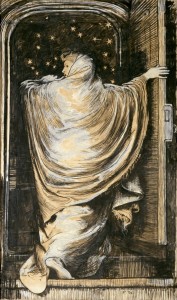
Anne Catherick is the Woman in White. In the novel, The Woman in White by Wilkie Collins, Anne’s character initially serves as the catalyst for many crucial events that occur. For example, when Walter first sees Anne, he is left with an overwhelming amount of curiosity. Then later, when Anne reacts negatively to Sir Percival, it serves as indication that he has evil tendencies, thus causing her to react this way. As the novel progresses, Anne is frequently looked to in hopes of providing information about certain tendencies or histories of other characters. Toward the end of the novel, it is even revealed that Laura and Anne are half-sisters. There is no question Anne’s role in the novel is vital.
However, despite Anne’s significance in the plot of The Women in White, she finds an untimely, and rather anticlimactic farewell. After hearing Percival’s aspiration to obtain her money in the event of her death, Laura becomes more unsettled and desperate than she already is. However, if Laura were to fake her death, she would then be released of her obligation as Glyde’s wife. Luckily, at this exact point in the novel, Anne becomes terminally ill and dies. Although Anne is the title character and many of the early plot points revolve around her, she coincidentally dies in a very non-extraordinary way. Further, no one is even aware that she has died, because it is stated that Laura has died instead. After everything, Anne was not even officialy awarded her own death. In Walter’s narration it is stated, “In the eye of reason and of law, in the estimation of relatives and friends, according to every received formality of civilised society, ‘Laura, Lady Glyde’ lay buried with her mother in Limmeridge churchyard” (413). The focus of the novel consistently revolved around Laura.
Since the novel was published, there have been copious interpretations and revisions, both in writing and in other art forms. One intriguing interpretation is the painting, The Woman in White (1871) by Frederick Walker. What is so fascinating about this piece, in particular, is the facial expression of the woman. The piece is very simple, and mundane. The colors incorporated are quite earthy and bland. However, the appearance of the woman is very frantic as she exits the room, as if she were running away from something. When looking at this painting, thoughts of Anne’s anticlimactic death resurface. In a painting such as this, perhaps ‘the woman in white’ is not Anne at all, but rather Laura. Could this interpretation be a depiction of Laura, disguised as Anne, finally able to run from Sir Percival? For it is realized that, regardless of Anne’s importance, the focus of the novel was always, ultimately, Laura.
I do not disagree with your premise that Laura is the woman in white but could we assume that the two women, Anne and Laura, are almost “condensed” (in the Freudian sense) together and both appear in the illustration to represent the Woman in white? Both figures could be seen attempting to ascend (depicted by the stairs in the illustration) to a more heavenly place (based on the stars) where they will not be tormented by the threat of death or imprisonment.
I agree with your interpretation that while Anne appears to be the novels namesake Laura is undoubtedly the character the novel circles. I think this is interesting in connection with how interchangeable Anne and Laura seem to be, especially after Laura is in the Asylum. Is the vagueness of the title supposed to show how Anne and Laura are similar? Because both women are legally invisible and let down by the law, they inhabit a similar female space. However, the more Collin sets them us as comparisons the more they both seem to disappear into “the woman in white”.